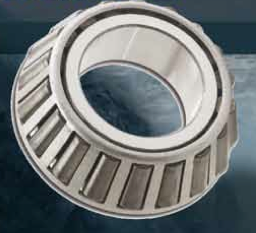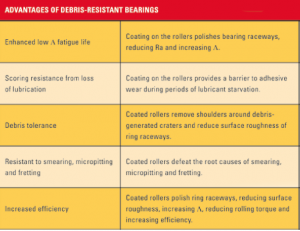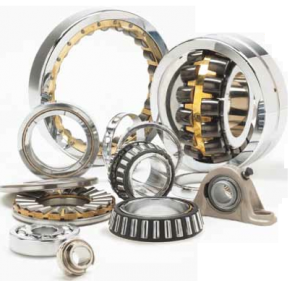By Gary L. Doll, Ph.D., Chief Technologist, The Timken Company
 Since the late 1990s, coatings on bearing rollers provide wear resistance, debris resistance and friction reduction for demanding customer applications. However, more than a decade of intensive research and development resulted in a new coating technology that expands the performance of rolling element bearings well beyond the previous limits.
Since the late 1990s, coatings on bearing rollers provide wear resistance, debris resistance and friction reduction for demanding customer applications. However, more than a decade of intensive research and development resulted in a new coating technology that expands the performance of rolling element bearings well beyond the previous limits.
A number of years ago, Timken and other bearing companies started using coatings on rollers for niche bearing applications. The most widely used coating for bearing rollers was a tungsten carbide containing amorphous hydrocarbon coating commonly called tungsten diamondlike carbon. In late 2008, Timken performed extensive application testing of bearings with this coating, which was commercially available from a number of different sources. Researchers concluded that this coating was not durable enough to provide performance improvements for the majority of bearing applications.
Wanting to understand why this was the case, the team performed an in-depth analysis of the coating and identified a defect that might be responsible for the limited durability of the coating. A second study focused specifically on eliminating that defect during the coating deposition process, and a new coating without this defect was created. When Timken tested bearings with this new coating on the rollers, the bearings performed far better than any bearings the company had ever tested.
For example, Timken research saw a 3.5 to four times improvement in the fatigue life of roller bearings. After reviewing over 100 years of data, it was concluded that this coating may be the most significant improvement that has been seen in roller bearing performance to date.
Timken’s experience with debris-resistant bearings for mining applications dates back to 2003. The prior coating technology targeted increased performance in high debris environments operating with marginal lubrication conditions. This enhanced product offering with Timken’s new coating applied to rollers has increased equipment uptime at mines throughout the world.
In addition to improved debris resistance and unparalleled low lambda fatigue life, this new coating technology further expands the capabilities of Timken’s debris resistance offering by addressing life-limiting wear such as scoring, smearing, micropitting, and fretting. Conditions that promote these life-limiting wear modes are commonplace in underground mining applications, including continuous miners, long wall shears, and shuttle cars as well as in above ground haulage and excavation equipment applications such as mine truck wheels, dragline fairlead sheaves, boom point sheaves and hoist and drag drum gearboxes.
Based on The Timken Company’s experience and understanding of mining applications and operating environments, the validation of these enhanced debris resistant bearings is just another step toward providing customers increased performance and improved machine uptime even in the world’s most extreme operating conditions.
 In addition to bearings, this new coating can also be applied to shafts, gears, seal riding surfaces and more. Just as adverse conditions and environments impact bearings, they also impact other key components operating in mining applications. These components can also benefit from this new coating technology to improve performance in the overall system.
In addition to bearings, this new coating can also be applied to shafts, gears, seal riding surfaces and more. Just as adverse conditions and environments impact bearings, they also impact other key components operating in mining applications. These components can also benefit from this new coating technology to improve performance in the overall system.
Technology impact
Since roller bearings seldom operate in well-lubricated application environments, they do not often experience the number of cycles for which they were designed. In low lambda situations, asperities on the rollers and raceways come into contact and bearing life is reduced. Lambda is the ratio between the lubricant film thickness and the composite surface roughness of the rollers and raceways.
Timken observed that during operation, the new coating on the rollers of debris resistant bearings creates very smooth ring raceways that significantly reduce asperity interactions. This polishing has been found to continue until the roller and raceway surfaces are fully separated by the lubricant film and the bearing is no longer operating in a low lambda situation.
Interruption of the supply of lubricant to bearings can result in severe adhesive wear between the rollers and contacting surfaces on the rings. Depending upon the loads and speeds, the adhesive wear rates increase until scuffing, scoring or galling occurs. The roller coating will not participate in adhesive wear with steel, but if the loads and speeds in the contacting areas are large enough and the lubricant interruption is long enough, the coating on the rollers can wear. Once the coating is worn away, adhesive wear can ensue, but while the coating is wearing, it allows the bearing to remain operational.
Debris particles, which pass through worn seals, that were not removed after manufacture, or generated by wear of other components like gears can damage bearing surfaces if the particles are larger than the thickness of the lubricant film. Depending upon the hardness and brittleness of the particle, the particles can generate dents on the raceway and/or roller surface. During the denting process, displaced material creates shoulders around debris craters. These shoulders can create very high subsurface stresses and fatigue cracks can initiate at relatively low stress cycles.
Because the new roller coating is almost twice as hard as the steel raceways, it removes these shoulders through the same kind of polishing action that was described above. As a result, the stress risers that can cause early fatigue crack initiation are greatly reduced, allowing the bearing to operate much longer than it would otherwise.
 If high loads are applied to skidding rollers in low lambda situations, the frictional heat from roller/raceway sliding can increase the surface temperature to the point that the steel melts. This melting and subsequent resolidification process weakens the steel and creates a smeared appearance when it occurs on bearing raceways. In laboratory tests designed to produce smearing wear on cylindrical and spherical roller bearings, Timken has not been able to produce smearing in the bearings where the new coating has been applied to the rollers. This result is attributed to the extremely high durability of the roller coating and its low friction coefficient against steel.
If high loads are applied to skidding rollers in low lambda situations, the frictional heat from roller/raceway sliding can increase the surface temperature to the point that the steel melts. This melting and subsequent resolidification process weakens the steel and creates a smeared appearance when it occurs on bearing raceways. In laboratory tests designed to produce smearing wear on cylindrical and spherical roller bearings, Timken has not been able to produce smearing in the bearings where the new coating has been applied to the rollers. This result is attributed to the extremely high durability of the roller coating and its low friction coefficient against steel.
Cyclic shear stresses from skidding rollers in low lambda conditions can create bearing damage known as low cycle micropitting. Rollers with the new coating can greatly reduce the shear stresses from skidding rollers that cause low cycle micropitting to occur in bearings.
As described above, the coated rollers create very smooth raceways during bearing operation through a dynamic micropolishing action. The effect of this polishing creates raceways with roughness values much lower than those obtained with traditional finishing processes. As a result, bearings with ultra-smooth raceways operate at higher lambda ratios with the same amount of lubrication compared to conventional bearings.
A common engineering practice to increase bearing life in low lambda conditions is to use lubricants with high viscosities to create thicker lubricant films. But high viscosity lubricants can substantially decrease the efficiency of a mechanical system. On the other hand, bearings with this new coating on the rollers can achieve much higher lambda ratios with lower viscosity lubricants, thereby realizing efficiency improvements that have been measured as high as 15 per cent.
These advanced bearings are useful in almost every market space that Timken currently serves. For example, the durability of this coating and its ability to provide protection during periods of interrupted lubrication has enabled the development of a new, high-efficiency turbine engine for commercial jets.
Timken also sees this technology being used systemically. For another example, if gears were to use this coating, it may be possible to eliminate EP additives from lubricants. That could enable the use of low torque polymer-type cages in gearbox bearings, increase the life of elastomer seals and provide a cost saving by using less expensive and “greener” lubricants. This technology offers a host of reasons and benefits for using it, and opens up new areas for exploration and development.
Timken debris-resistant bearings are the result of breakthroughs in the materials and process improvements associated with the development of this new coating. The functionality of the coating in these bearings may establish a new paradigm for understanding tribological coatings. Coatings are typically thought of as a “defensive” measure, and this coating certainly functions that way. However, this new coating also produces significant benefits by working offensively improving or repairing the surfaces that it runs against. This is how the large boost in low lambda fatigue life, the lower rolling torque or friction and the “debris tolerance” attributes of debris-resistant bearings are achieved.